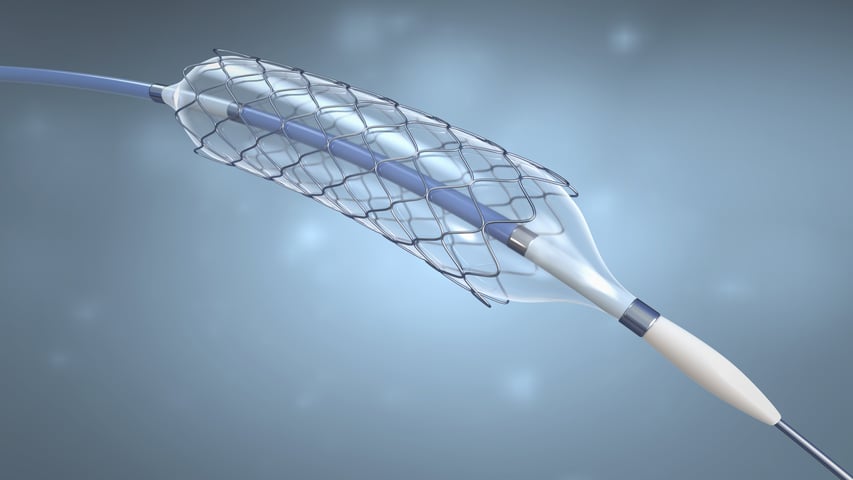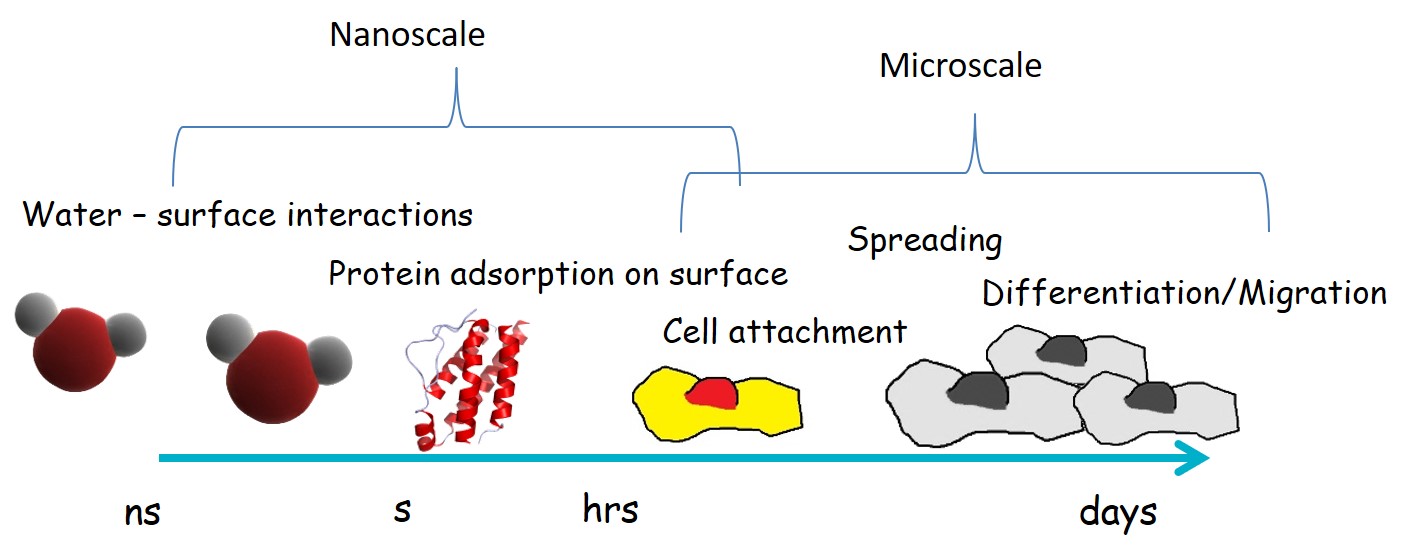
When a biomaterial is placed in the human body different molecular interactions take place at the material surface. The types of interactions are affected by the surface properties of the material such as surface chemistry, wettability and surface roughness. The surface phenomena can be roughly divided into four stages, water-surface interactions, protein adsorption, cell attachment and cell spreading, and proliferation.

The initial response when a material is placed in the biological surroundings is the water molecule adsorption to its surface. This happens within the first few nanoseconds. It is commonly known that water behaves differently with different materials. It can either spread on the surface or form a droplet on it with a measurable angle (i.e. contact angle). Based on this the surface is classified either hydrophilic or hydrophobic.
The behavior of water on biomaterial surface has long been under investigation as that is the basis of the role of a biomaterial surface in biological response. To what extend water – surface interactions affect the protein adsorption and later cell – biomaterial interactions are still under investigation.
In the second stage, the protein adsorption occurs. Proteins are observed on a biomaterial surface under a second after implantation in a living system. In seconds to minutes, a monolayer of protein adsorbs to the most surfaces. It is generally accepted that the small proteins will be the first to adsorb due to their rapid transport to the surface. Over time these proteins are replaced by bigger ones that have a greater affinity towards the surface [1]. The affinity of the proteins is a major principle determining the outcome of the competitive adsorption process. For example, the three major plasma proteins are albumin, IgG, and fibrinogen whereas the amount of hemoglobin in plasma is much less. Still adsorbed amounts of hemoglobin are similar to predominant proteins due to higher surface affinity [2].
The third stage of biological response includes the cell attachment to the surface. This stage is influenced by the adsorbed protein layer as well as surface topography. As the protein adsorption occurs well before cells arrive at the surface, the cells primarily see the adsorbed protein layer rather than the biomaterial surface itself.
Cell spreading and differentiation are known to be influenced especially by both microscale roughness and wettability. It is usually reported that biomaterial surfaces with moderate hydrophilicity improved cell growth and higher biocompatibility. However, cell adhesion can decrease as the material becomes very hydrophilic. This points out the existence of a range of optimal surface energies [3].
As the nano- and microscale roughness also plays a role here, it is important to be able to determine when the cell spreading is modulated by surface free energy, topography or both [4].
If you are interested in reading more about why wettability is important in biomedical applications, please download the overview through the link below.
[1] P. Roach, D. Englin, K. Rohde and C. C. Perry, “Modern bio¬materials: a review - bulk properties and implications of surface modifications”, Journal of material science: Materials in medicine 18 (2007) 1263.
[2] T.A. Hobert (2004), “The role of adsorbed proteins in tissue response to biomaterials” in B. D. Ratner et. a. (ed.) Biomaterial science: An introduction to materials in medicine. Elsevier Academic Press 237.
[3] R.E. Baier, “Surface behavior of biomaterials: the theta surface for biocompatibility”, Journal of material science: Materials in medicine 17 (2006) 1057.
[4] J. I. Rosales-Leal, M. A. Rodríguez-Valverde, G. Mazzaglia, P. J. Ramón-Torregrosa, L. Díaz-Rodríguez, O. García-Martínez, M. Vallecillo-Capilla, C. Ruiz and M. A. Cabrerizo-Vílchez, “Effect of roughness, wettability and morphology of engineered titanium surfaces on osteoblast-like cell adhesion”, Colloids and surfaces A: Physicochemical and Engineering aspects 365 (2010) 222.
Membrane wettability is a key property to ensure success of membrane distillation process
Hydrophobic surface properties are needed in contact with the food product while hydrophilicity is needed when printing on food packaging.
Wettability is pivotal in pharmaceutical dosage form manufacturing as well as in drug efficacy.
Understanding the wettability of membranes is essential for optimizing these processes and achieving desired separation outcomes.
Wettability is important in various pharmaceutical process steps from the manufacturing of solid dosage forms to their disintegration and dissolution
Calendering, a common compaction process for Li-ion batteries, will significantly impact the pore structure and thus also the wettability of the electrode.
The wettability of different parts of Li-ion batteries is a key issue in terms of manufacturing, performance, and safety of the batteries.
Hydrophilic surface properties are needed in many different applications ranging from biomedical devices to marine engineering.
The effect of Surface roughness and wettability on biocompatibility of biomaterials and Medical devices.
